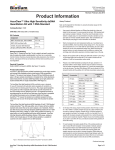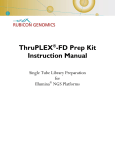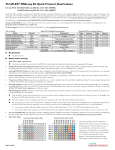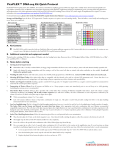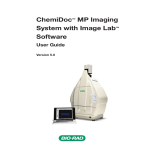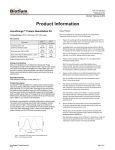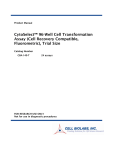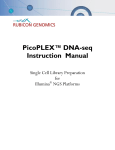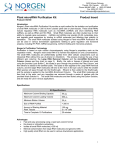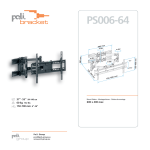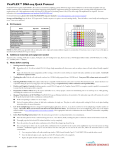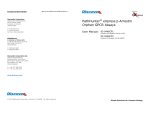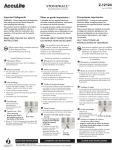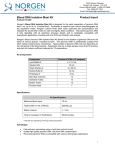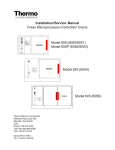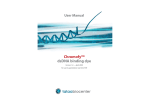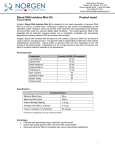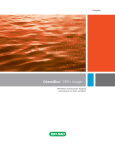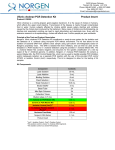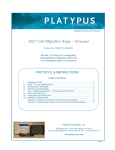Download Product Information
Transcript
Glowing Products for Science 3159 Corporate Place Hayward, CA 94545 www.biotium.com TM Revised: May 1, 2015 Product Information AccuBlue™ NextGen dsDNA Quantitation Kit Assay Protocol 1. Use properly calibrated pipettes and DNase-free pipette tips, tubes and plates for best accuracy. It is recommended to test each DNA standard and each unknown sample in triplicate. Because the assay sensitivity is highly dependent on the accuracy and sensitivity of the plate reader, we recommend performing an inital standard curve to determine the linear range supported by your plate reader (results for the plate readers we have tested are shown in Table 1 as a guideline). See Considerations for Data Analysis (next page) for more information on DNA standards. 2. Warm all components to room temperature before use. AccuBlue™ NextGen Dye is provided in DMSO, which may freeze during storage at 4°C. You can place all kit components in a 37°C water bath for rapid warming; be sure to allow solutions to cool to room temperature before using. Before removing the required volume, mix each component well by shaking or vortexing, and centrifuge vials briefly before opening to minimize reagent loss on the cap. 3. Prepare a set of DNA standards by diluting the 300 pg/uL standard in 1X AccuBlue™ NextGen Buffer as shown below. If your reader is sensitive enough to detect DNA amounts below 5 pg, you can follow the instructions for preparing 0.25 and/or 0.1 pg/uL standards in Considerations for Data Analysis (next page). Volumes may be scaled as necessary. The DNA dilutions should be prepared fresh on the day of assay. Catalog Number: 31060-T AccuBlue™ NextGen dsDNA Quantitation Kit, trial size 31060 AccuBlue™ NextGen dsDNA Quantitation Kit Kit Contents Component 31060-T 200 assays 31060 1000 assays AccuBlue™ NextGen Dye, 400X 1 X 100 uL 99808-T 1 x 500 uL 99808 AccuBlue™ NextGen Enhancer, 100X 1 x 1 mL 99809 2 x 1 mL 99809 AccuBlue™ NextGen Buffer, 1X 1 x 50 mL 99810-T 1 x 200 mL 99810 AccuBlue™ NextGen DNA Standard, 300 pg/uL 1 X 0.5 mL 31060A-T 2 x 1 mL 31060A Storage and Handling Store kit at 4oC. Protect Dye from light. The kit is stable for at least 6 months from date of receipt when stored as recommended. AccuBlue™ NextGen Dye is a potentially harmful chemical. Exercise universal laboratory safety precautions when handling the dye, and dispose of the dye as hazardous chemical waste according to your local regulations. Spectral Properties Ex/Em: 468/507 nm (bound to dsDNA). See Figure 1 for spectra. Product Description The AccuBlue™ NextGen dsDNA Quantitation Kit provides unprecedented accuracy and sensitivity to low amounts of DNA. It is ideal for use in quantifying DNA from low-concentration or precious samples, and for quantifying DNA for use in sensitive applications such as Next-Gen Sequencing (NGS) or digital PCR. The AccuBlue™ NextGen assay is linear between 5 pg and 3 ng of dsDNA per assay (see Figure 2), which corresponds to sample concentrations of 0.5 pg/uL to 300 pg/uL in the 96-well microplate format (depending on the sensitivity of the plate reader, see Table 1). Unlike absorbance-based measurements, AccuBlue™ NextGen Dye is highly selective for double-stranded DNA over single stranded DNA or RNA. 300 400 500 Wavelength (nm) 600 700 Figure 1. Absorbance and emission spectra of AccuBlue™ NextGen Dye bound to dsDNA. AccuBlue™ NextGen dsDNA Quantitation Kit PS006 Concentration A 300 pg/uL 31060A AccuBlue NextGen DNA Standard, 300 pg/uL stock -- B 50 pg/uL 10 uL of A 50 uL C 10 pg/uL 12 uL of B 48 uL D 2 pg/uL 12 uL of C 48 uL E 0.5 pg/uL 15 uL of D 45 uL F 0 ng/uL -- 60 uL 4. On the day of the assay, prepare working solution. You will need 200 uL of working solution for each standard and sample to be tested. Prepare only as much working solution as you plan to use immediately. 5. Prepare working solution in a plastic container (do not use a glass container) by diluting AccuBlue™ NextGen Dye at a ratio of 1:400 and AccuBlue™ NextGen Enhancer at a ratio of 1:100, in AccuBlue™ NextGen Buffer. For example, to test 6 standards and 4 samples in triplicate, you would add 15 uL Dye and 60 uL Enhancer to 6 mL Buffer. Mix well by vortexing or shaking to ensure that Dye and Enhancer are fully dispersed, and use immediately. Some precipitation may occur over time if working solution is prepared and allowed to sit before use. 6. For each sample to be tested, pipette 200 uL of the working solution per well of a black flat-bottom 96-well microplate. To test samples in triplicate, prepare three separate wells for each DNA standard and three separate wells for each unknown DNA sample. Accurate multi-channel pipettes and reagent reservoirs can be used to increase throughput. Black plates are recommended to minimize fluorescence bleed-through between wells. We have found that black 96-well plates from Greiner Bio One or Corning give the most consistent signal-to-noise ratio at low DNA concentrations. 7. Add 10 uL of each dsDNA standard into its own separate well containing working solution and mix well by pipetting up and down. 8. Pipette 10 uL of each unknown DNA into its own separate well containing working solution and mix well by pipetting up and down. Emission Absorbance The AccuBlue™ NextGen dsDNA Quantitation assay is designed for use with fluorescence microplate readers equipped with excitation and emission filters for detecting green fluorescence. The unique spectral properties of AccuBlue™ NextGen dye make it especially well-suited for use with instruments with blue LED excitation sources, such as Biotium’s AccuLite™ 470 handheld fluorometer. Because the AccuBlue™ NextGen dsDNA Quantitation assay is so sensitive, results will vary depending on several factors including: microplate reader sensitivity and accuracy, pipeting accuracy, and assay volume. DNA 1X AccuBlue NextGen Buffer Standard Page 1 of 3 9. Incubate the microplate at room temperature for 5 minutes in the dark. 10. Measure fluorescence using a microplate reader set to 468 nm excitation/507 nm emission maxima or other similar filter combination for detecting green fluorescence. 11. Generate a standard curve to determine the unknown DNA concentration (see Figure 2). Average the triplicate values for each sample and subtract the average 0 ng DNA value from each data point. Plot the fluorescence values for the DNA standards on the y-axis and pg/well DNA on the x-axis, and fit a trend line through these points to generate a standard curve with a y-intercept = 0. Use the equation for the standard curve trend line to calculate the amount of unknown DNA in each well (y = fluorescence and x = pg DNA per well). Note: the standard curve shown in Figure 2 is for reference only. You must generate your own standard curve using your instrument to calculate the amount of DNA in your unknown samples. Table 1 assay format (assay volume) reader Lowest DNA detected 96-well (200 uL) 1 pg 384-well (50 uL) 0.6 pg Biotek Synergy™ H1m 96-well (200 uL) 5 pg Spectramax® Gemini XS 96-well (200 uL) 5 pg AccuLite™ 470 PCR tube (200 uL) 5 pg BMG CLARIOStar® Table 2 Considerations for Data Analysis Calf thymus DNA can serve as a reference for most plant and animal DNA because it is double-stranded, highly polymerized and is approximately 58% AT (42% GC). Lambda dsDNA yields similar results. You may wish to use a standard similar to your unknown samples in DNA length, structure (i.e., linear vs. circular), or GC content. For bacterial DNA, a species-specific standard may be desired because the GC content varies widely depending on the species. The stated linear range of the AccuBlue™ NextGen dsDNA Quantitation assay extends from 5 pg to 3 ng, when following the above protocol. We have observed accuracy down to 1 pg or lower, depending on the microplate reader and assay volume (Table 1). If lower concentration standards are desired, you can prepare 0.25 pg/uL and/or 0.1 pg/uL standards. For 0.25 pg/uL, combine 5 uL of the 2 pg/uL standard with 35 uL buffer; for 0.1 pg/uL, combine 10 uL of the 0.5 pg/uL standard with 40 uL of buffer. Use 10 uL of these standards in the assay to obtain 2.5 pg and 1 pg data points. It is recommended to prepare the standards on the same day as the assay is performed. Compound Initial concentration in DNA sample Final concentration in assay (200 uL) Decrease in Signal Sodium Chloride 500 mM 25 mM 7% Magnesium Chloride 100 mM 5 mM 30% Sodium Acetate 600 mM 30 mM 11% Ethanol 20% 1% 8% Phenol 2% 0.10% 10% SDS 0.2% 0.01% 87% SDS 0.02% 0.001% 13% Triton X-100 0.2% 0.01% 18% Triton X-100 0.02% 0.001% 8% Tween-20 0.1% 0.005% 8% dNTPs 2 mM 100 uM 1% If the fluorescence of any of the unknown samples is higher than the linear range, further dilute the sample and add 10 uL of the diluted sample to perform the assay. For consistency, it is best to use the same volume of sample in all the wells. Due to differences in instruments, check instrument settings to optimize for the best linearity. Some factors that can affect the final linearity and relative fluorescence intensity are: (1) the excitation and emission wavelengths and bandwidths, (2) cut-off filters, (3) sensitivity (gain) settings, (4) pipetting accuracy, and (5) microplate manufacturer. The effects of common DNA contaminants such as salts, solvents, detergents and nucleotides on the AccuBlue™ NextGen assay are listed in Table 2. Related Products Catalog number Product E90001 AccuLite™470 Mini Fluorometer 31027 AccuClear™ Ultra High Sensitivity dsDNA Quantitation Solution (1000 assays) 31028 AccuClear™ Ultra High Sensitivity dsDNA Quantitation Kit with 7 DNA Standards (1000 assays) 31006 AccuBlue™ High Sensitivity dsDNA Quantitation Kit (1000 assays) 31008 AccuBlue™ High Sensitivity dsDNA Quantitation Solution (1000 assays) 31007 AccuBlue™ Broad Range dsDNA Quantitation Kit 31009 AccuBlue™ Broad Range dsDNA Quantitation Solution 41003 GelRed™ Nucleic Acid Gel Stain, 10,000X in water 31041-T Forget-Me-Not™ qPCR Master Mix, trial size 31003-T Fast EvaGreen® qPCR Master Mix, trial size Please visit our website at www.biotium.com for information on our life science research products, including environmentally friendly EvaGreen® qPCR master mixes, fluorescent CF™dye antibody conjugates and reactive dyes, apoptosis reagents, fluorescent probes, and kits for cell biology research. Figure 2. Linearity of AccuBlue™ NextGen dsDNA quantitation assay between 5 and 3000 pg per well in a 96-well microplate assay with excitation/emission at 468/507 nm. The inset shows the lower portion of the curve. AccuBlue, AccuClear, and AccuLite are trademarks of Biotium, Inc. AccuBlue technology is covered by U.S. Patents. Materials from Biotium are sold for research use only, and are not intended for food, drug, household, or cosmetic use. AccuBlue™ NextGen dsDNA Quantitation Kit PS006 Page 2 of 3 Appendix: Instructions for performing an AccuBlue NextGen assay on the AccuLite 470 Fluorometer Sample Preparation Note: if using Mini Glass Tubes, 100 uL sample volume can be used. Scale all volumes in the reaction (working solution and DNA) proportionally. 1. Prepare standards as described in the Assay Protocol on page 1. 2. Prepare working solution as described in the Assay Protocol. 3. For each standard and sample to be tested, pipette 200 uL of the working solution into a 0.2 mL thin-walled clear PCR tube. To test samples in triplicate, prepare three tubes for each sample. 4. Prepare samples by pipetting 10 uL of each sample DNA per tube. Pipette up and down or vortex to mix. Incubate in the dark, 5 min. Main Menu Measure Calibrate Info Data 1. Select Measure Sample Measurement 1. Do not perform any Calibration (the instrument is not set up to do AccuBlue NextGen calibration, so raw fluorescence values much be taken and analyzed as in the plate reader assay). Proceed directly to Measurement. 2. From the AccuLite Main Menu, select Measure. 3. Select Next from the assay list. 4. Select RFU Hi. 5. Insert the first sample tube and close the cover. Select Measure. Write down the given value. This value is given in Relative Fluorescence Units (RFU). 6. Insert the next sample and select Measure again. Repeat with all remaining standards and samples. 7. Follow the instructions in Assay Protocol step 11, page 2, to generate a standard curve and calculate your sample concentration. Accu dsDNA AccuOrange Assay 3 Next 2. Select Next RFU Hi RFU Lo 3. Select RFU Hi RFU Hi Measure Return 4. Insert first standard or sample tube and select Measure. [Timer] [Data Value] Measure Return 5. Manually record the data value. 6. Insert the next standard or sample tube, select Measure, and repeat the process for each sample. Figure 3. AccuLite user menu tree showing the steps for performing the AccuBlue NextGen assay on the AccuLite 470. See the AccuLite user manual for complete user menu tree. AccuBlue™ NextGen dsDNA Quantitation Kit PS006 Page 3 of 3



